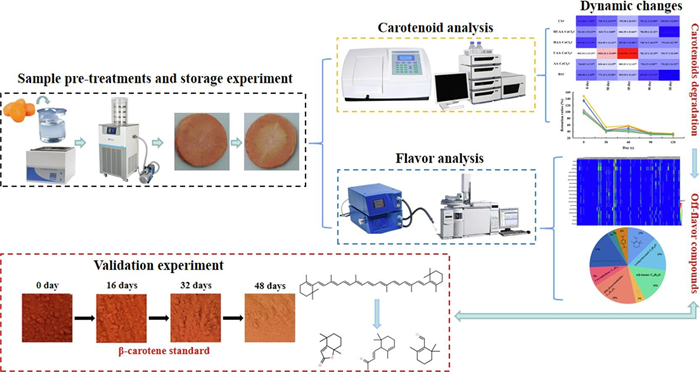Researchers from IFST-CAAS explored the influence of different pre-treatments on flavor quality of freeze-dried carrots mediated by carotenoids and metabolites during 120-day storage
Carrots are known as the “King of Vegetables” and are widely consumed for their rich nutritional content, bioactive substances, unique flavor and texture. The ultrasonic (40 KHz, 10 min) combined with ascorbic acid (2%, w/v)-calcium chloride (1%, w/v) osmotic pre-treatment (H/UAA-CaCl2) can improve the color quality of freeze-dried carrots (FDC) by preserving the carotenoid, however, the effects of H/UAA-CaCl2 on the product’s flavor quality is still unclear. Moreover, there is a lack of systematic research on the relationship between carotenoid monomers, carotenoid degradation products, and product flavor.
The Fruit and Vegetable Processing and Nutrition Health Innovation group of Institute of Food Science and Technology (IFST), Chinese Academy of Agricultural Sciences (CAAS) has successfully independently investigated the changes in carotenoids monomers and volatiles (including β -carotene-metabolites) of FDC treated by H/UAA-CaCl2 during a 120-day storage period.
The results of HS-SPME/GC–MS showed that caryophyllene was the dominant volatile compound (70.80–275.74 µg/g, d.b) in FDC, and 144 volatile compounds were detected in 6 samples. Besides, 23 volatile compounds were significantly correlated with β -carotene content ( p < 0.05), and β -carotene degraded to off-flavor compounds ( β -ionone: 22.85–117.26 µg/g, β -cyclocitral: 0–113.84 µg/g and dihydroactindiolide: 4.04–128.37 µg/g) that had adverse effects on FDC flavor. However, UAA-CaCl2 effectively preserved the total carotenoid content (793.37 µg/g), and HUAA-CaCl2 reduced the off-odors (such as β -cyclocitral and isothymol) formation at the end of storage. These results indicated that (H)UAA-CaCl2 treatments were conducive to the maintenance of carotenoids and the flavor quality of FDC.
The above research was published in the JCR Q1 journal Food Research International (IF: 8.1). Lyu Ying is the first author of the paper, Prof. Bi Jinfeng and Prof. Chen Qinqin are the co-corresponding authors. This work was supported by the Science and technology project in Gansu Province (21ZD4NA01) and the Agricultural Science and Technology Innovation Program, Institute of Food Science and Technology, Chinese Academy of Agricultural Sciences (CAAS-ASTIP-2022-IFST). The support of the China Scholarship Council (202108210257) for the first author is acknowledged.

https://doi.org/10.1016/j.foodres.2023.113050
-
 Apr 18, 2024Opening Ceremony of the Training Workshop on Wheat Head Scab Resistance Breeding and Pest Control in Africa Held in CAAS
Apr 18, 2024Opening Ceremony of the Training Workshop on Wheat Head Scab Resistance Breeding and Pest Control in Africa Held in CAAS -
 Apr 03, 2024IPPCAAS Co-organized the Training Workshop on Management and Application of Biopesticides in Nepal
Apr 03, 2024IPPCAAS Co-organized the Training Workshop on Management and Application of Biopesticides in Nepal -
 Mar 28, 2024Delegation from the School of Agriculture and Food Science of University College Dublin, Ireland Visit to IAS, CAAS
Mar 28, 2024Delegation from the School of Agriculture and Food Science of University College Dublin, Ireland Visit to IAS, CAAS -
 Mar 25, 2024Director of World Food Prize Foundation visited GSCAAS
Mar 25, 2024Director of World Food Prize Foundation visited GSCAAS -
 Mar 20, 2024Institute of Crop Sciences (ICS) and Syngenta Group Global Seeds Advance Collaborative Research in the Seed Industry
Mar 20, 2024Institute of Crop Sciences (ICS) and Syngenta Group Global Seeds Advance Collaborative Research in the Seed Industry
